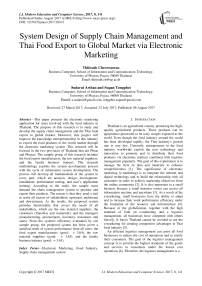System Design of Supply Chain Management and Thai Food Export to Global Market via Electronic Marketing
Автор: Thitirath Cheowsuwan, Sudarat Arthan, Supan Tongphet
Журнал: International Journal of Modern Education and Computer Science (IJMECS) @ijmecs
Статья в выпуске: 8, 2017 года.
Бесплатный доступ
This paper presents the electronic marketing application for users involved with the food industry in Thailand. The purpose of this research is to study and develop the supply chain management and the Thai food export to global market. Moreover, this project will improve the knowledge entrepreneurship in this industry to export the food products to the world market through the electronic marketing system. This research will be focused in the two provinces of Thailand that are Phrae and Phayao. The sample group of this research includes the food export manufacturers, the raw material suppliers, and the family business trainees. The research methodology exploits the system development process with the cycle of information system development. The process will develop all fundamentals of the system in every part, which are analysis, design, development, installation, performance testing, and user’s application training. According to the study, the sample users demand the chain management system to produce and export their products. The reason is that they need a tool to assist all sectors of stakeholders; upstream, midstream and downstream. As the results, the proposed system provides functionality that covers the needs of all stakeholders, which are the raw material suppliers, the customers (franchise and restaurant), and the managers (manufacturing, procurement, inventory, restaurant, and sales). From the system's efficiency evaluation by our sample group, the proposed system has been given a satisfied result of system performance from all users: the food export manufacturers (good: = 3.64), the raw material suppliers (good: = 3.63), and the family business trainees (good: = 3.63).
Electronic Marketing, Food Industry, Supply chain management system
Короткий адрес: https://sciup.org/15014989
IDR: 15014989
Текст научной статьи System Design of Supply Chain Management and Thai Food Export to Global Market via Electronic Marketing
Thailand is an agricultural country producing the high-quality agricultural products. These products can be agriproduct processed to be tasty recipes exported to the world. Even though the food industry around the world has been developed rapidly, the Thai industry's growth rate is very low. Currently, entrepreneurs in the food industry worldwide exploit the new technology and innovation to promote and to distribute their food products via electronic markets combined with logistics management popularly. The goal of this exploitation is to manage the flow of data and materials to enhance competitiveness [1]. The significance of electronic marketing (e-marketing) is to integrate the internet and digital technology and to build the relationship with all customers in order to achieve marketing objectives from the online community [2]. It is also important to a small business because a small business owner can access all information anytime and anywhere [3]. As a result of the e-marketing, small businesses have the ability to adapt and to increase their work performance efficiency under the limitation of the resource and infrastructure [4]. Because of the globalization, together with the high standard of both an e-marketing and a logistics management, all businesses have competed with others fiercely. It forces Thailand cannot be avoided to use the e-marketing for creating competitive advantages in Thai food industry [5].
An efficient logistics management can assist all food businesses to reduce the cost of operations and to satisfy their consumers. The goal of the logistics management concept is to provide the highest standards of the goods and services to consumers under the lowest cost operations [6]. Therefore, the logistics management is a part of the supply chain process to provide all needs for a business owner to all consumers such as planning, supporting, controlling, storing, informing, and servicing respectively [7]. The efficient food industry management system should cover all tasks of the logistics process and value chain from the upstream sector to the downstream sector in the food industry. In summary, all Thai food businesses need to utilize the new technology and innovation of the e-marketing to support the operation of their industry. This technology and innovation will expand their customer bases in widely varying social, and also increase the customer relationship effectively. Therefore, this research is the one way to support and to enhance the export of Thai food products to the global market.
The aims of the development of management system for chain manufacturing and exporting Thai food to the global market with e-marketing methods are to create an enterprise resource planning, to support supply chain management and Thai food export. These aims will cover all needs of users in supply chain management. They include the suppliers of raw materials (farmers, housewives, and wholesalers), the food manufacturers (restaurants and agriproduct businesses), the distributors (wholesale stores and franchises), the retailers (franchise restaurants and international restaurants), and the consumer of Thai food respectively. The proposed system (the peak of inflated expectations period). They include the internet of things (IoT) architecture, iBeacons and Bluetooth beacons, predictive analytics, and smart transportation etc.
Moreover, in the next 5-10 years, IT/OT integration, IoT, and wearables will play the role of this business [8]. The Gartner’s prediction can be shown in figure 1.
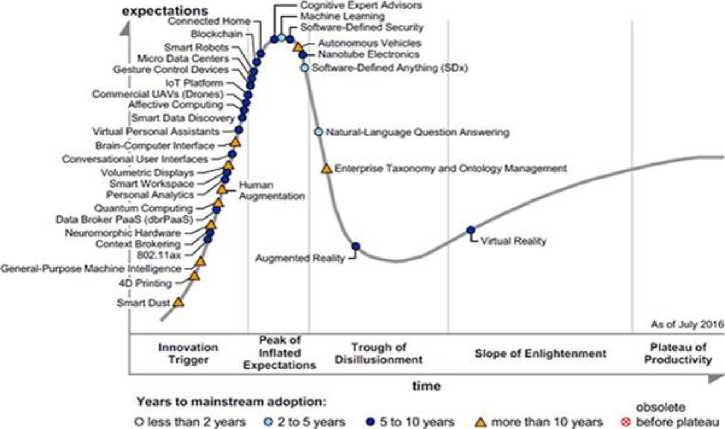
Fig.1. Gartner’s hype cycle for IoT in 2015 [8].
-
II. Methods
The methodology of system development life cycle (SDLC) is adapted to this research. This system development consists of six steps: analysis, design, development, assessment, installation, and training. First, the aims of the system analysis are to study all demands of the system application and then to analyse the studied information for procedures of the food industry in both Phrae and Phayao provinces. Moreover, this information is also used to create a process modelling system and a system analysis report. The system analysis report includes the context diagram, the data flow diagram, ER diagram, and data dictionary respectively. And then, this system analysis will be used to support for software programming in this project. Second, the aim of the system design is to apply all results of the system analysis for designing the physical model. This model is composed of both the technological elements of design (programming language, operating system, and database management system) and the system elements of design (output design, input design, user interface design, and database design). Third, the aim of the system development is to use all results from the system analysis and the system design to create a computer program for building the algorithmic subsystems. And then, all subsystems will be connected to be the main system by using the database approach. This stage focuses on designing and developing the database by using a series of commands to store and to retrieve data effectively. It also creates all documentations of the system according to the standard of the developed system. Fourth, the aim of the system assessment is to use the system assessment form to range the system score based on Best’s approaches [9]. The approaches will interpret by determining the range of means into 5 levels. And then, all assessment results from this stage will be used to analyses and to choose for improving the system in accordance with the requirements of users. Fifth, for the system installation, this stage will install all providing services of the proposed system into the host computer in
Faculty of Information Technology and Communication, Phayao University for testing. Finally, for the system training, this stage will educate the sample groups with the use of the system, the management system, and the system maintenance respectively. It also provides the emarketing knowledge to the entrepreneurs, the suppliers, and the trainees to gain their competitiveness in the global business.
Population and sample groups of this research are the sample used for evaluating the effectiveness of both the supply chain management and the Thai food exports to the world market. They are a group that has specific characteristics. In other words, they are the food export manufacturers and the raw material suppliers of the local area in the north of Thailand (Phrae and Phayao). Moreover, this research also employs all trainees from the Phayao University students to study this project along with both manufacturers and suppliers simultaneously.
-
III. Research Instruments
The nonprobability sampling and purposive sampling techniques are used for choosing the sample groups of this project. They include thirty food export manufacturers, fifteen raw material suppliers, and thirty trainees. The tools used in this research are divided into two purposes: (1) the analysis and design system tools (Business Process Model Notation, Microsoft Word, Microsoft PowerPoint, and Microsoft Visio), (2) the system development tools (Web Application technology, Web Base Application technology, cloud computing, .NET technology, Microsoft Windows Server, SQL Server, and World Wide Web (WWW) services). For the system development tools, we employ a TCP/IP protocol to be the main standard for data communication in the system. The reason is that all users can access information by using the web browsers. Finally, we use mean, percentage, and standard deviation to be the tools to evaluate the system performance [10].
The tools used in the data correction are both a questionnaire of information system requirements and an evaluation information system: (1) The questionnaire of information system requirements is used to collect the facts and the requirement of the information system of the users. Its questions are divided into two categories, which are a free format question and a flexed format question. The advantage of those questions is that all users can answer with the varieties of the questions such as the multiple choices, the rating question, and the ranking question respectively. (2) The evaluation information system is used to analyze the sample group’s satisfaction of the information system. It can be divided into three steps: (1) The questions of the demographic factors are the personal information of each users such as gender, age, educational degree, and position. (2) The questions of the users’ satisfaction of the proposed information system are used in this step. (3) The general questions and suggestions are used in the final step.
The data analysis can be divided into two steps: (1) Non-functional requirements are the analysis data of the requirements about the quality of the tasks of the proposed software. It also analyses the users’ needs that are both quality and property of the desired software such as usability, efficiency, reliability, user friendliness, and portability respectively. (2) The analysis of the efficiency evaluation system performance is employed in this step. It is used to measure the sample users’ satisfaction after the software installation and its improvement.
The arithmetic average is utilized for statistical measurement [11] Its equations can be shown as
X = ^ X (1)
N where x is the mean, ∑ x is the sum of the estimated value, and N is the total number of the assessors.
Both the range of the mean [12] and the standard deviation [11] are used to interpret the mean of the users’ questionnaire as
SD-, n 2 * 2 * ) 2
У n ( n - 1 )
where x is the evaluation value, ∑ x is the sum of the estimated value, and n is the total number of the assessors.
-
IV. Problems and Obstacles
This research is faced with many uncontrolled factors. For example, either suppliers or entrepreneurs have to change the business owner. This causes the changes of the operational staff positions in the organization. This problem is unavoidable affecting to the data correction directly. The drawback of this situation is that the researchers have to restart all processes of the users’ requirements again. As the results, all new comers change the requirements. Moreover, another problem is the difference of the computer system of each business such as the Internet and communication systems, computer devices, and the administrator’s knowledge.
-
V. Results
The study on the method of the e-marketing from food export entrepreneurs shows that eating behaviors affect the increment of the ready-to-eat food. This food can be divided into the three main categories [13-14]: chilled ready meals, frozen ready meals and dried ready meals. In the food industry, it is currently being distributed its products through the e-market increasingly. The reason is that it expands their customer bases widely affecting the growth of their food business. A recent study in Phrae and Phayao has found that all three main categories of food can be found in the local restaurants. Unfortunately, they cannot be found in the online marketing because the entrepreneurs lack of e-marketing knowledge. The study also found that both entrepreneurs and suppliers require online technologies to support their business. It is a directly market to the consumers by using the Internet technology to promote the sale of products and services. The e-marketing is also designed to suit the supply chains, which are the enterprise systems, people, technologies, activities, information, and other resources. It can use for trading goods and services from a manufacturer to an end customer conveniently [15].
The study on the demands of supply chain management and Thai food export is collected from our sample groups (the entrepreneurs, the suppliers, and the trainees) in Phrae and Phayao. They are also the research informants, the testers, and the evaluators respectively. The study found that the sample groups require an information system with twenty-one functionalities: suppliers and purchasing (seven functionalities), production (nine functionalities), and customers (five functionalities). This requirement can be used to create .
By using the system requirements, it can be used to create a use case diagram to show the relationship both a relationship of the system diagram and an enterprise resource planning process as shown in figure 2.
Between the actors and the system. They are linked with the related use cases. They are also used to explain the main function of the system to all actors [16]. The use case diagram of the system can be shown in figure 3.
After that, a class diagram is built to show the view of a system that focuses on the structure of objects, object classes, class relationships, attributes, and operations [16]. The architecture of the database system is designed with the ANSI/SPARC standard (or the three-level architecture).
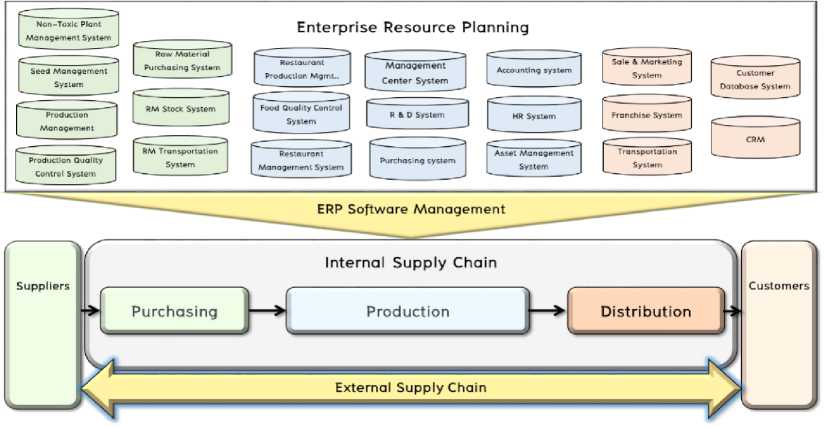
Fig.2. The enterprise resource planning system.
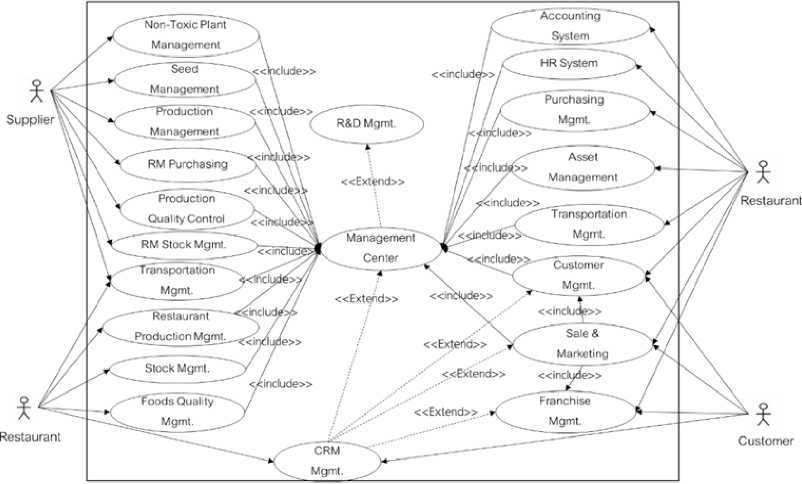
Fig.3. The use case diagram of the system.
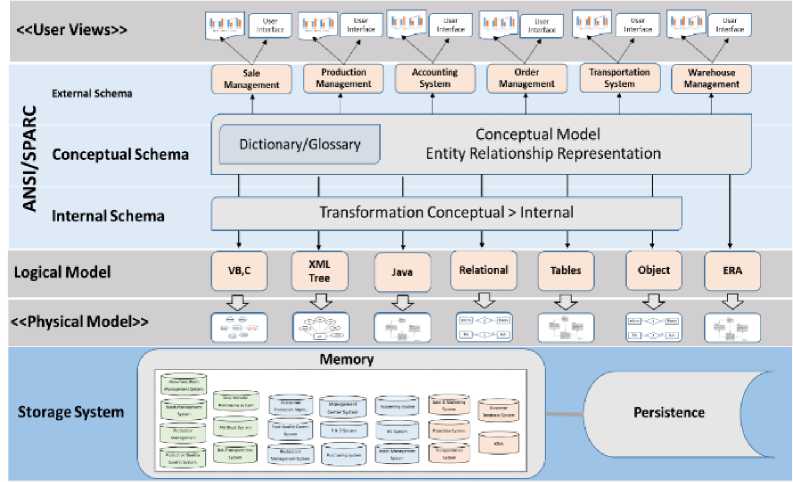
Fig.4. The architecture of the database system of chain management and Thai food export.
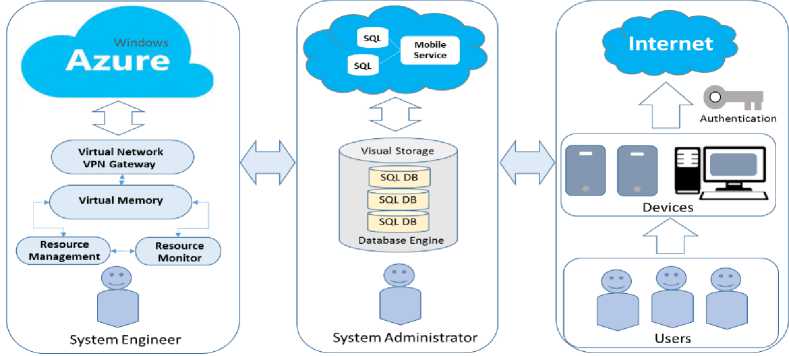
Fig.5. The virtual machine technology based on the IaaS infrastructure of the SCMTFES system.
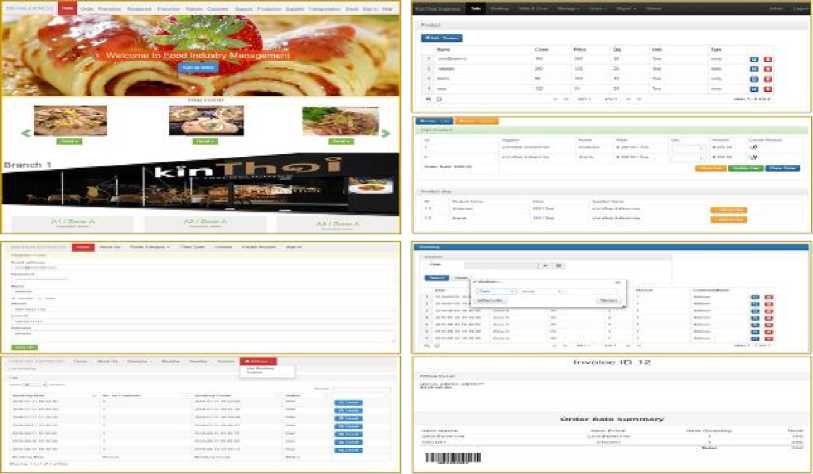
Fig.6. The captured screen of the database system of chain management and Thai food export.
This architecture can be viewed as three levels: an external view, a conceptual view, and an internal view [17]. First, the external view, it is used for showing the overall details of the database in order to connect between the relationship of the data and the criteria to the user. Second, the conceptual view, It is used for connecting between an internal view and an external view. Finally, the internal view, It is used for connecting between an internal view and an external view. Finally, the internal view, it is used to show the data storage and the data structure at the physical level [18-20]. The overall of the architecture of the database system can be shown in figure 4.
Figure 4 shows that the type of our storage system, which consists of twenty-one databases, is the persistence (the section at the bottom).
For the physical model and logical model, they are used for storing information to the storage section. Then, this information can be used to find the user’s information as the logical record. The system design based on SCMTFES system is compatible with the virtual machine relied on the IaaS infrastructure from cloud computing provider. It can be shown in figure 5.
From the overall study, the result of the data analysis and design is the supply chain management and food export software system. It consists of user’s functionalities to support and to manage data in the system: (1) Raw material suppliers (raw and material, production plan, and production and quality), (2) Food manufacturing managers (production plan, production and quality, sale and marketing, inventory, product delivery, food management, and customer data), (3) Procurement managers (production plan, production and quality, sale and marketing, inventory data, product delivery, restaurant management, franchise management, and customer data), (4) Heads of inventory (sale and marketing, inventory, product delivery, franchise management, and customer data), (5) Restaurant managers (sale and marketing, inventory, product delivery, restaurant management, food management, and customer data), (6) Sales managers (sale and marketing, inventory, product delivery, franchise management, and customer data), (7) Franchise customers (franchise of the ready meals. It can be classified into three main types of food products that are (1). The chilled ready management, food management, customer data, promotion data, and deliver data), (8) Customers (food data, customer data, promotion data, and deliver data). The proposed software application can be shown on the captured screen in figure 6 and the overall results can be mapped into a table as shown in Table 1.
Table 1. The summary of assessment results of supply chain management and Thai food export system.
|
Item |
Assessment Level |
||||||||
|
entrepreneurs |
suppliers |
student entrepreneurs |
|||||||
|
X |
S.D. |
Level |
X |
S.D. |
Level |
X |
S.D. |
Level |
|
|
1.Functional Requirement |
3.75 |
0.25 |
good |
3.85 |
0.19 |
good |
3.71 |
0.17 |
good |
|
2. System Design |
3.65 |
0.19 |
good |
3.65 |
0.21 |
good |
3.61 |
0.23 |
good |
|
3. Performance |
3.57 |
0.25 |
good |
3.54 |
0.27 |
good |
3.58 |
0.24 |
good |
|
4. Reliability |
3.58 |
0.21 |
good |
3.60 |
0.25 |
good |
3.57 |
0.28 |
good |
|
5. Usability |
3.64 |
0.20 |
good |
3.51 |
0.32 |
good |
3.70 |
0.21 |
good |
|
Summery |
3.64 |
0.03 |
good |
3.63 |
0.05 |
good |
3.63 |
0.04 |
good |
-
VI. Sumary In A CCORDANCE WITH THE O BJECTIVES OF THE R ESEARCH
By the using of the sample group’s requirements, it can be used to build a system model, and then it can be used as a guide of the system development. The model consists of the Supplier Management, the Customer Management, the Customer Order, the Food Management, and the eMarketing. They are consistent with the objectives of the research in Article 1, The Study and Design of the Chain Management System for the Thai Food Exports to the World Market. The study found that the eating behaviors of the people affect the demand meals, (2) The frozen ready meals, and (3) The dried ready meals. In the food industry currently, the ready-to-eat foods have distributed through the e-Marketing widely. It enables the market expansion rapidly, and the food business is growth by the size of the online marketing.
In the study case in Phare and Phayao, they have all three types of the ready meal for their business. It is consistent with the objectives of the research in Article 2, The Study on the Implementation of the Entrepreneurs Food Exports and the Development of Applications on the Electronic Marketing.
In the study case in Phare and Phayao, they have all three types of the ready meal for their business. It is consistent with the objectives of the research in Article 2, The Study on the Implementation of the Entrepreneurs Food Exports and the Development of Applications on the Electronic Marketing.
This research provides e-Marketing knowledge to the entrepreneurs and the newcomers through four activities:
Activity 1 . E-Marketing Training for Students and Novice Entrepreneurs on 17 May 2016. The target group is 50 students of the Computer Business, Information and Communication Technology Faculty.
Activity 2 . The Training of the Entrepreneurial Development and Thai Agricultural Product Marketing Promotion to the World Market on 27 May 2016. The target group is the restaurant entrepreneurs in Phare and
Phayao for 30 people, who are onsite 10 people and online 20 people.
Activity 3 . The Training of the Using of the Chain Management System and Food Export by e-Marketing on 15 June 2016. The target group is the novice entrepreneur students for 50 students.
Activity 4 . The Training of the Using of the Chain Management System and Food Export by e-Marketing on 7 August 2016. The target group is the restaurant entrepreneurs for 45 people.
-
VII. Conclusion
The electronic marketing application for Thai food export has been presented in this paper. The main aim of the proposed application is to study and to develop the supply chain management and the Thai food industry to the global market. The proposed e-marketing system is also used to provide the knowledge entrepreneurship to the local people who are involved in this business. The sample groups are chosen from the northern provinces of Thailand, which are Phrae and Phayao. They can be divided into three main groups: the food export manufacturers, the raw material suppliers, and the family business trainees. The cycle of information system development is employed by the system development process to develop the research methodology. This research covers all system designs and applications from upstream to downstream such as analysis, design, development, installation, performance testing, and user’s application training respectively. As the assessment results, the user’s scores in every aspect of the proposed system is at the good level.
Список литературы System Design of Supply Chain Management and Thai Food Export to Global Market via Electronic Marketing
- Li, S., B. Ragu-Nathan, T.S. Ragu-Nathan and S.S. Rao. 2006. The impact of supply chain management practices on competitive advantage and organizational performance. The International Journal of Management Science 34: 107-124.
- Chaffey, D., & Smith, P., R. (2008). Emarketing excellence: Planning and optimizing your digital marketing (3rd ed.). Oxford, United Kingdom: Butterworth Heinemann.
- Lam, H.T.L. (2010) E-marketing Channels: The digital influence on small sized businesses. Bachelor’s Thesis Business Management Mikkeli, University of Applied Sciences.
- Rajarathnam, O.E.(2010). E-Marketing: The utilization of e-Marketing in small business enterprises. The Degree of Master of Science, University of South Australia School of Computer and Information Science.
- Cho, J. J. K., J. Ozment, and H. Sink. 2008. “Logistics Capability, Logistics Outsourcing and Firm Performance in an E-Commerce Market.” International Journal of Physical Distribution & Logistics Management 38 (5): 336-359.
- Stank, T. P. and C. W. Lackey, Jr. 1997. “Enhancing Performance Through Logistical Capabilities in Mexican Maquiladora Firms.” Journal of Business Logistics 18 (1): 91-123.
- Lambert, D. M., M. C. Cooper, and J. D. Pagh. 1998. “Supply Chain Management: Implementation Issues and Research Opportunities.” Journal of Logistics Management 9 (2): 1-20.
- Gartner's 2016 Hype Cycle for Emerging Technologies Identifies Three Key Trends That Organizations Must Track to Gain Competitive Advantage [Internet]. 2016 [cited 2017 February 10]; Available from: http://www.gartner.com/newsroom/id/3412017
- Chusak Janprakon. CRM System: Satisfying Service to Customer? Human Resources Development Journal, Ramkhamhaeng University 2010;6:60-73.
- Lenk, Alexander, et al. What’s inside the Cloud? An architectural map of the Cloud Landscape. In CLOUD’ 09. Proceeding of the 2015 ICSE Workshop Software Engineering Challenges of Cloud Computing; 2015; Germany; 2015.p.23-31.
- Luan Saiyos and Angkana Saiyos. The Development Techniques and Scholastic of Aptitude Test And General Test. Chomromdek. Bankok, 1998.
- Best, J.W. 1981. Research in Education. New Jersey : Prentice – Hall.
- Satapana Promboon. 2010. Thailand along with food, Ready-to-eat. Investment Journal, 21 (4): 6-10.
- Research Information Services, Food Institute. 2008. Guide … the market penetration of Chinese food. 1th Bangkok; Food Institute.
- Porntipha Ongkunarak. 2010. Introduction to Supply Chain Management. Faculty of Agriculture, Bangkok; Kasetsart University.
- Chalee Vorakulpipat, Theparit Banditwattanawong. UML Language for Software Developer. UML Bangkok: SE-Education Public Company; 2001.
- Eva Lindencrona-Ohlin Goteborg. A study on conceptual data modeling. Eva Lindencrona-Ohlin; 1979.
- ETH Zurich. Journal Of Object Technology Online. Chair of Software Engineering ©JOT [Internet]. 2003 [cited 2016 September 10];2:2. Available from:http://www.jot.fm.
- D.C. Tsichritizis, A., Klug (Eds.). The ANSI/X3/SPARC DBMS framework: report of the study group on database management systems. Information Systems 1978; 3.
- Metasafe Repository. Information Models [Internet]. 2016 [cited 2016 September 10]. Available from: http://www.metasafe-repository.com/metaModeler.html

